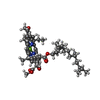+Search query
-Structure paper
| Title | In situ high-resolution structure of the baseplate antenna complex in Chlorobaculum tepidum. |
|---|---|
| Journal, issue, pages | Nat Commun, Vol. 7, Page 12454, Year 2016 |
| Publish date | Aug 18, 2016 |
 Authors Authors | Jakob Toudahl Nielsen / Natalia V Kulminskaya / Morten Bjerring / Juha M Linnanto / Margus Rätsep / Marie Østergaard Pedersen / Petar H Lambrev / Márta Dorogi / Győző Garab / Karen Thomsen / Caroline Jegerschöld / Niels-Ulrik Frigaard / Martin Lindahl / Niels Chr Nielsen /     |
| PubMed Abstract | Photosynthetic antenna systems enable organisms harvesting light and transfer the energy to the photosynthetic reaction centre, where the conversion to chemical energy takes place. One of the most ...Photosynthetic antenna systems enable organisms harvesting light and transfer the energy to the photosynthetic reaction centre, where the conversion to chemical energy takes place. One of the most complex antenna systems, the chlorosome, found in the photosynthetic green sulfur bacterium Chlorobaculum (Cba.) tepidum contains a baseplate, which is a scaffolding super-structure, formed by the protein CsmA and bacteriochlorophyll a. Here we present the first high-resolution structure of the CsmA baseplate using intact fully functional, light-harvesting organelles from Cba. tepidum, following a hybrid approach combining five complementary methods: solid-state NMR spectroscopy, cryo-electron microscopy, isotropic and anisotropic circular dichroism and linear dichroism. The structure calculation was facilitated through development of new software, GASyCS for efficient geometry optimization of highly symmetric oligomeric structures. We show that the baseplate is composed of rods of repeated dimers of the strongly amphipathic CsmA with pigments sandwiched within the dimer at the hydrophobic side of the helix. |
 External links External links |  Nat Commun / Nat Commun /  PubMed:27534696 / PubMed:27534696 /  PubMed Central PubMed Central |
| Methods | EM (single particle) / NMR (solid-state) |
| Resolution | 26.5 Å |
| Structure data | |
| Chemicals |  ChemComp-BCL: |
| Source |
|
 Keywords Keywords | bacteriochlorophyll binding protein /  photosynthesis / light-harvesting protein / binds bacteriochlorophyll a / photosynthesis / light-harvesting protein / binds bacteriochlorophyll a /  oligomeric complex oligomeric complex |
 Movie
Movie Controller
Controller Structure viewers
Structure viewers About Yorodumi Papers
About Yorodumi Papers






